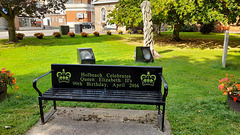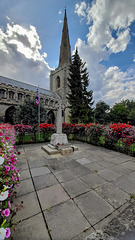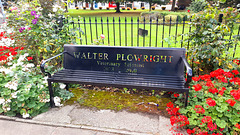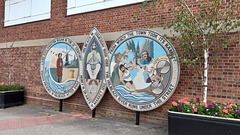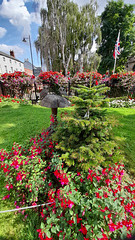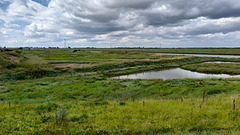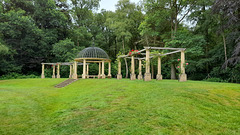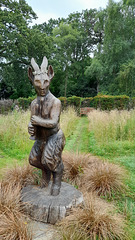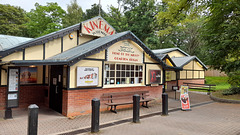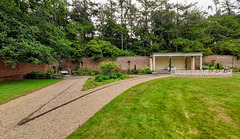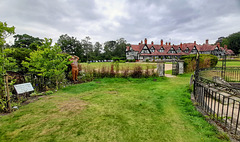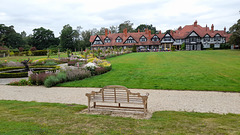Ste's photos
HFF Sunrise from Lincolnshire
| |
|
|
|
HBM from Holbeach ~ Lincolnshire
| |
|
|
|
HFF from Sandringham Estate ~ Norfolk
| |
|
|
|
War memorial ~ Holbeach ~ Lincolnshire
| |
|
|
|
War memorial and All Saints church ~ Holbeach ~ Li…
| |
|
|
|
HBM from Holbeach ~ Lincolnshire
| |
|
|
|
Walter Plowright
Walter Plowright CMG FRS FRCVS (20 July 1923 in Holbeach, Lincolnshire – 19 February 2010 in London) was an English veterinary scientist who devoted his career to the eradication of the cattle plague rinderpest. Plowright received the 1999 World Food Prize for his development of tissue culture rinderpest vaccine (TCRV), the key element in the quest to eliminate rinderpest. Rinderpest became the first animal disease to be eliminated worldwide.
He was the second son of Jonathan and Mahala Plowright. He attended Moulton Grammar School which transferred to Spalding Grammar School in 1939. He graduated from the Royal Veterinary College in London in 1944 and was commissioned into the Royal Army Veterinary Corps.
As a young veterinary pathologist, Plowright carried out research in Kenya and Nigeria. The East African Veterinary Research Organization at Muguga in Kenya provided the base for Plowright and his colleagues to adopt the cell-culture techniques used to develop the polio vaccine to produce a live attenuated (non-pathogenic) virus for use as a rinderpest vaccine.
Plowright used a mono-layer of kidney cells to culture the virus until it became non-virulent and could be transmitted from one cattle to another, producing lifelong immunity against rinderpest. Unlike its predecessors, tissue culture rinderpest vaccine (TCRV) could be used safely in all types of cattle, it could be produced very economically and conferred lifelong immunity.
The research and application techniques that brought Plowright success in fighting rinderpest were later replicated by his colleagues to vaccinate against sheeppox and lumpy skin disease.
In 1964, Plowright returned to the United Kingdom to oversee animal disease research there until his 1983 retirement. He chaired the Royal Veterinary College’s microbiology and parasitology department from 1971 to 1978. He was Head of Microbiology at the Institute for Animal Health in Compton, Berkshire from 1978 to 1983. In addition to rinderpest, Plowright also contributed to the study of such viral animal diseases as African swine fever, malignant catarrhal fever, poxviruses, and herpesviruses.
He was awarded a Fellowship of the Royal Society of London and received the Order of St Michael and St George. He also received the World Organisation for Animal Health's Gold Medal and the Animal Health Trust’s Outstanding Scientific Achievement Award. He was awarded the King Baudouin International Development Prize 1984-1985 by the Belgian monarch
All Saints Church ~ Holbeach ~ Lincolnshire
| |
|
|
|
The church dates back to 1225, and so has been a place of witness and worship where God has been honoured for the past 800 years.
For all of those 800 years All Saints has been here for the whole community of Holbeach. It has baptised, married and buried local people; it has been a place of thanksgiving during times of joy and celebration; and a place of sombre prayer and intercession during times of plague and national or local mourning. Its’ very stones hold more prayer and memories than we can possibly imagine, and it still stands to fulfil the same purpose for the people of the 21st century
Holbeach
| |
|
|
|
Holbeach awash with colour
| |
|
|
|
HFF from Moulton Marsh ~ Lincolnshire
| |
|
|
|
"Temple of Atalanta", a neo-classical Italianate d…
| |
|
|
|
"The lookout" and remains of prototype bouncing bo…
| |
|
WAR DAYS AND THE DAMBUSTERS .
The hotel building served as a military hospital for injured soldiers during the Great War complete with wards and an operating theatre, but it is as the home of the legendary 617 “Dambusters” Squadron in WW2 that the Petwood is best known. Occupied from 1942, it was originally home to officers of both 97 and 619 squadrons, but when 619 squadron moved to RAF Coningsby and 617 squadron moved to RAF Woodhall Spa the officers of 617 made the Petwood their home.
Composed of Canadian, New Zealand and Australian as well as British Royal Air Force personnel, 617 Squadron were a top-secret squadron entrusted with the specific task of crippling three key German Dams. Carried out on the night of May 17th 1943, this crucial attack was called “Operation Chastise” and utilised an ingenious “Bouncing Bomb” designed by engineer Sir Barnes Wallis. The bouncing explosive was a stroke of genius, able to be launched directly at targets before it detonated underwater, creating a “bubble pulse” effect capable of causing huge damage to enemy targets. The Squadrons badge, picturing a breached wall, and motto “Apres moi, le deluge” (“After me, the flood”) pay homage to the effectiveness of the mission.
Today, the Squadron Bar hosts a range of memorabilia and tributes to Wing Commander Guy Gibson VC, Group Captain Leonard Cheshire VC and their Officers. The Petwood was a scene of some jubilant celebrations with the breakthroughs made by 617 Squadron, as well as soul searching after tragic losses. We can only imagine the sheer bravery of the Squadron and the huge risks they took in enemy territory, facing death time and again. Guy Gibson alone, the squadron’s heroic young Wing Commander, carried out over 170 raids by the age of 24. Just two years later he was killed in action.
The squadron’s feats live on at the Petwood, which remains a fascinating testament to the Dambusters as well as all the squadrons and RAF personnel who visited or stayed over the years. Besides the attacks that destroyed or damaged the dams and industry in the Ruhr Valley, the Squadron was also responsible for the sinking of the German warship Tirpitz, which had been concealed in the Norwegian Fjords, with the new Tall Boy bomb. Alongside other squadrons, 617 squadron were also involved in raids on other key targets including bridges, shelters and canals as well as using the innovative 'Grand Slam' bomb to destroy U-boat shelters, railway bridges and viaducts in Germany. In 2010 it was also uncovered that they were being considered for a special mission to target Mussolini himself.
Sculpture of Pan "god of the wild" in the grounds…
| |
|
|
|
HBM from the "Kinema in the woods" ~ Woodhall Spa
| |
|
|
|
The Kinema in the Woods started life as a sports and entertainment pavilion dated from the late 19th Century. The pavilion sat in the grounds of The Victoria Hotel, looking over tennis courts, croquet lawns and gardens, until The Victoria Hotel burnt down on Easter Sunday 1920, this led to the relationship between the hotel and the pavilion being severed.
In 1922, Sir Archibald and Lady Weigall purchased the Victoria Hotel ruins including the sports pavilion and, with the assistance of Captain Carleton Cole Allport, the pavilion was transformed into a cinema which opened its doors on Monday September 11th 1922 at 7pm. The first film to be shown was intended to be "The Lion Eaters", however the film failed to arrive and a Charlie Chaplin film was shown in its place.
Due to the roof trusses in the building, which are too low for an image to be projected from the back of the auditorium, films in Screen One at The Kinema are projected from behind the screen and on to a mirror to flip the image. This is then shown on the back of the screen. The Kinema is believed to be the only full-time cinema in the UK still using rear projection.
Most of the auditorium (the current Screen One) was fitted with tip-up seats, however the front six rows were deck chairs. These seats were much sought after at at 1s 6d (other seats ranged from 1s 3d to 6d). The deck chairs remained in The Kinema until 1953.
The first sound projector was installed in The Kinema in 1928 and was replaced in 1978 by two electronically controlled projectors.
Major C. C. Allport ran the cinema for over 50 years, until 1973 when it was taken over by James Green who also owned a cinema in Stone, Staffordshire and later owned and ran cinemas in Spilsby and Mablethorpe.
In June 1987 Mr Green installed a Compton Kinestra organ in The Kinema, which features an ornate lacquered red and gold console with an eighteenth century oriental design. The organ is still situated in Screen One and played regularly by The Kinema's resident organist, Alan Underwood .
A 92-seat auditorium, Kinema Two, was opened on Friday July 8th 1994 with a screening of "Four Weddings and A Funeral". The auditorium walls of Screen Two depict scenes of rural Lincolnshire in trompe l’oeil style painted by Canadian artist Murray Hubick.
In June 2019 a Third Auditorium was opened, with a screening of the film "Yesterday" to an invited audience.
The Kinema in the Woods remains a privately owned family business and is open every day of the year except Christmas Day
HFF from Lincolnshire
| |
|
|
|
HBM from the Petwood Hotel ~ Woodhall Spa
| |
|
|
|
HFF from the Petwood Hotel ~ Woodhall Spa
| |
|
|
|
WAR DAYS AND THE DAMBUSTERS .
The hotel building served as a military hospital for injured soldiers during the Great War complete with wards and an operating theatre, but it is as the home of the legendary 617 “Dambusters” Squadron in WW2 that the Petwood is best known. Occupied from 1942, it was originally home to officers of both 97 and 619 squadrons, but when 619 squadron moved to RAF Coningsby and 617 squadron moved to RAF Woodhall Spa the officers of 617 made the Petwood their home.
Composed of Canadian, New Zealand and Australian as well as British Royal Air Force personnel, 617 Squadron were a top-secret squadron entrusted with the specific task of crippling three key German Dams. Carried out on the night of May 17th 1943, this crucial attack was called “Operation Chastise” and utilised an ingenious “Bouncing Bomb” designed by engineer Sir Barnes Wallis. The bouncing explosive was a stroke of genius, able to be launched directly at targets before it detonated underwater, creating a “bubble pulse” effect capable of causing huge damage to enemy targets. The Squadrons badge, picturing a breached wall, and motto “Apres moi, le deluge” (“After me, the flood”) pay homage to the effectiveness of the mission.
Today, the Squadron Bar hosts a range of memorabilia and tributes to Wing Commander Guy Gibson VC, Group Captain Leonard Cheshire VC and their Officers. The Petwood was a scene of some jubilant celebrations with the breakthroughs made by 617 Squadron, as well as soul searching after tragic losses. We can only imagine the sheer bravery of the Squadron and the huge risks they took in enemy territory, facing death time and again. Guy Gibson alone, the squadron’s heroic young Wing Commander, carried out over 170 raids by the age of 24. Just two years later he was killed in action.
The squadron’s feats live on at the Petwood, which remains a fascinating testament to the Dambusters as well as all the squadrons and RAF personnel who visited or stayed over the years. Besides the attacks that destroyed or damaged the dams and industry in the Ruhr Valley, the Squadron was also responsible for the sinking of the German warship Tirpitz, which had been concealed in the Norwegian Fjords, with the new Tall Boy bomb. Alongside other squadrons, 617 squadron were also involved in raids on other key targets including bridges, shelters and canals as well as using the innovative 'Grand Slam' bomb to destroy U-boat shelters, railway bridges and viaducts in Germany. In 2010 it was also uncovered that they were being considered for a special mission to target Mussolini himself.
HBM from the Petwood Hotel ~ Woodhall Spa
| |
|
|
|
WAR DAYS AND THE DAMBUSTERS .
The hotel building served as a military hospital for injured soldiers during the Great War complete with wards and an operating theatre, but it is as the home of the legendary 617 “Dambusters” Squadron in WW2 that the Petwood is best known. Occupied from 1942, it was originally home to officers of both 97 and 619 squadrons, but when 619 squadron moved to RAF Coningsby and 617 squadron moved to RAF Woodhall Spa the officers of 617 made the Petwood their home.
Composed of Canadian, New Zealand and Australian as well as British Royal Air Force personnel, 617 Squadron were a top-secret squadron entrusted with the specific task of crippling three key German Dams. Carried out on the night of May 17th 1943, this crucial attack was called “Operation Chastise” and utilised an ingenious “Bouncing Bomb” designed by engineer Sir Barnes Wallis. The bouncing explosive was a stroke of genius, able to be launched directly at targets before it detonated underwater, creating a “bubble pulse” effect capable of causing huge damage to enemy targets. The Squadrons badge, picturing a breached wall, and motto “Apres moi, le deluge” (“After me, the flood”) pay homage to the effectiveness of the mission.
Today, the Squadron Bar hosts a range of memorabilia and tributes to Wing Commander Guy Gibson VC, Group Captain Leonard Cheshire VC and their Officers. The Petwood was a scene of some jubilant celebrations with the breakthroughs made by 617 Squadron, as well as soul searching after tragic losses. We can doonly imagine the sheer bravery of the Squadron and the huge risks they took in enemy territory, facing death time and again. Guy Gibson alone, the squadron’s heroic young Wing Commander, carried out over 170 raids by the age of 24. Just two years later he was killed in action.
The squadron’s feats live on at the Petwood, which remains a fascinating testament to the Dambusters as well as all the squadrons and RAF personnel who visited or stayed over the years. Besides the attacks that destroyed or damaged the dams and industry in the Ruhr Valley, the Squadron was also responsible for the sinking of the German warship Tirpitz, which had been concealed in the Norwegian Fjords, with the new Tall Boy bomb. Alongside other squadrons, 617 squadron were also involved in raids on other key targets including bridges, shelters and canals as well as using the innovative 'Grand Slam' bomb to destroy U-boat shelters, railway bridges and viaducts in Germany. In 2010 it was also uncovered that they were being considered for a special mission to target Mussolini himself.


